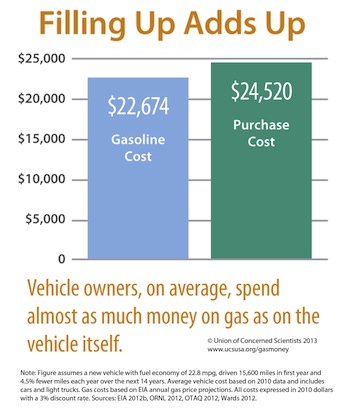Most Americans don’t realize how much money they spend
on gas and how much they would save if they owned a more fuel efficient car.
Over the time they own a car, most people spend almost as much on gas as the purchase price of a car … and most of that money goes right into the pockets of oil companies, according to an analysis by the Union of Concerned Scientists (UCS).
Based on current prices at the pump, a typical driver will spend an eye-popping $22,674 over the next 15 years to fill up a 2011 model car that gets 22.8 miles per gallon – slightly less than the $24,520 s/he paid to buy the car.
$33 of every $50 it costs to fill a car with gas goes directly to oil companies. Just 81 cents goes to the local gas station owner, and less than 1 cent goes to shareholders of oil company stocks.
That means that if a driver bought a car in 2011 and drove it for 15 years – the lifetime for an average vehicle – $14,000 of the $22,000 they spend on gas goes straight to oil companies.
“Filling up at the pump isn’t cheap,” says Joshua Goldman, the report’s author and policy analyst for UCS’s Clean Vehicles program. “You’re basically paying for a second car every 15 years. The only thing really benefitting from your oil use is oil companies’ bottom line.”

In contrast, thinking more about fuel efficiency can deliver large returns for drivers over time.
For instance, while a Ford Fusion SE Hybrid costs $3,500 more than the base version of the conventional gas model, it will cost $9,000 less in gasoline over its lifetime – a net savings of more than $5,000.
Thanks to historic new fuel economy requirements for cars, people will save much more at the pump, regardless of the car they buy. By 2025, drivers will save a combined $1.7 trillion at the pump – about $8000 per vehicle – because of these standards, which require fleets to average 54.5 miles per gallon for model years 2017-2025.
The US will consume 12 billion fewer barrels of oil, and by 2025 reduce oil consumption by 2.2 million barrels a day – as much as half of the oil we import from OPEC every day.
“Since the oil industry profits from our fill-ups, we cannot expect them to lead the charge to cut our oil use,” says Goldman. “Thankfully, it’s easier than ever for consumers to choose fuel efficiency and keeping the money saved on gas in their pockets and their communities instead of oil company coffers.”
Read UCS’s plan on how to cut projected oil use in half by making vehicles, aviation and buildings more energy efficient.
